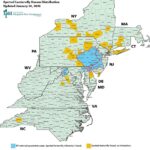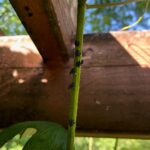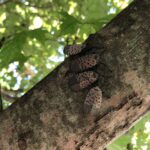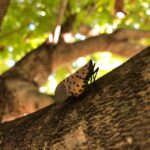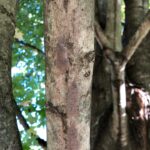Table of Contents
ToggleLast Updated on May 4, 2025
You may have heard about a new pest that has invaded landscapes in New Jersey and other surrounding states: The spotted lanternfly. This insect is an invasive plant hopper, which means that it can be found on multiple species of plants. Since the spotted lanternfly is not limited to a specific plant, it can be, and likely will be, a formidable pest in our landscape.
The spotted lanternfly originated in China, Vietnam, and India. It was first confirmed in the United States in 2014, when it was found in Pennsylvania. It is believed they hitchhiked here on landscape rocks. Since then, the spotted lanternfly has spread to New Jersey and several other surrounding states. Below is the spotted lanternfly distribution map from the New York State Integrated Pest Management website.
Spotted Lanternfly distribution map
Stages of the Spotted Lanternfly
The spotted lanternfly has one generation per year, with four nymph stages, an adult stage, and then overwinter in egg masses. The early nymph stages of the spotted lanternfly are usually found in the May-June timeframe, they are approximately ¼ of an inch long, black in color with white spots.
As they progress, the nymphs grow to about ¾ of an inch long and turn red in color, with black and white spots. Adult spotted lanternflies will reach 1 inch in length.
The adult spotted lanternfly has pinkish-tan, black-spotted folded wings. Both the male and female spotted lanternfly have a yellow abdomen with black bands. When the spotted lanternfly takes flight, the wings are moth-like and spread to about two inches.
Egg masses are found from October through the following spring. Spotted lanternfly egg masses have been found on trees, rocks, playsets, cars, etc. They look like a blotch of mud sticking to a hard surface and have a waxy covering. Additionally, each female potted lanternfly can lay one or two egg masses containing 30-60 eggs.
Spotted lanternfly Damage
The spotted lanternfly’s preferred host is the Tree of Heaven, Ailanthus altissima; however, they have been found on over 70 different plant species, including fruit trees, maples, and grapevines. In fact, there are several wineries in Pennsylvania that have lost significant portions of their crop in 2019 due to damage caused by the spotted lanternfly.
The spotted lanternfly damages plants by feeding on the sap. When the spotted lanternfly feeds on trees, they excrete a sugary substance called ‘Honeydew’. Sooty mold fungus is a dark colored fungus that grows on the honeydew and is a clear identifier of an insect issue on trees and shrubs. Since this pest can gather by the hundreds on trees, there is potential for significant damage. In large infestations, standing under a tree without an umbrella will not be a pleasant experience as you may feel the honeydew dripping on you like rain!
How to get rid of Spotted Lanternfly
So, what can you do about this pest? Since it is a relatively new pest to our area, Universities are still doing research on them. However, there are some things that can be done to minimize the spread and damage caused by spotted lanternflies.
- Removal of ‘Tree of Heaven’ on the property. Since this tree is the preferred host, many wineries and fruit farms have removed these trees surrounding their properties.
- Scout your property from June-October for spotted lanternfly activity.
- Inspect smooth surfaces from late fall to early spring for egg masses. This pretty much means everything outside that has a smooth surface. If you do see egg masses, scrape them off with a rigid plastic card into a bag. Once that is done, pour rubbing alcohol into the bag to kill the eggs.
- There are insecticides labeled to treat this pest, both curative and preventative. ‘Curative’ means treating them while they are actively feeding. ‘Preventative’ means treating the plant well before an expected infestation. Generally speaking, it is best to have a professional service apply insecticides.
- See it, squash it, smash it, kill it. Pretty self-explanatory.
In Conclusion
The spotted lanternfly has spread rapidly from a small area in Pennsylvania since 2014. They are now in New Jersey and at this point, you may have already noticed the adults on your property. They can be both a major nuisance to people and a pest to plants. If you have any questions about the spotted lanternfly, please give us a call.
For more information on Spotted lanternfly visit:
https://extension.psu.edu/spotted-lanternfly
https://www.nj.gov/agriculture/divisions/pi/prog/spottedlanternfly.html

